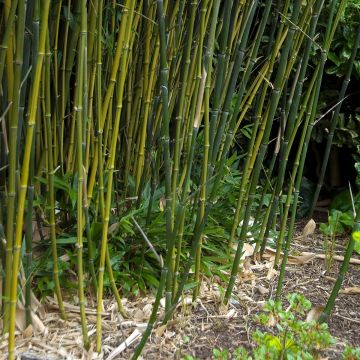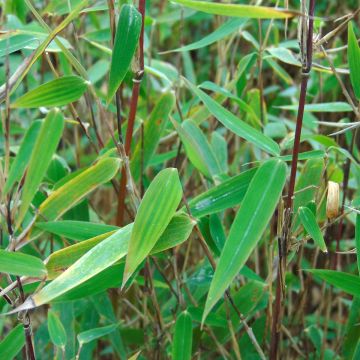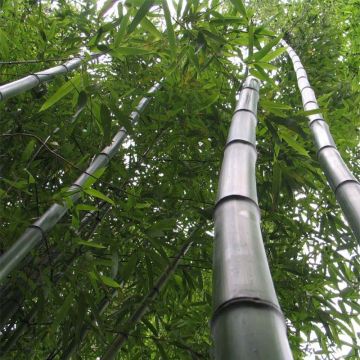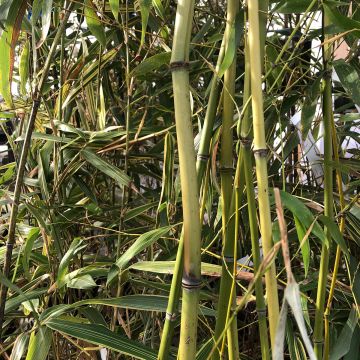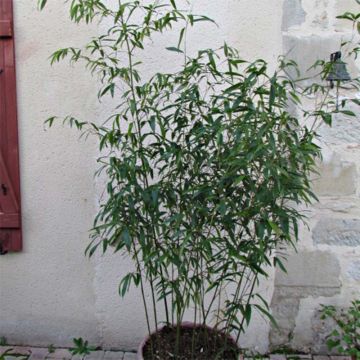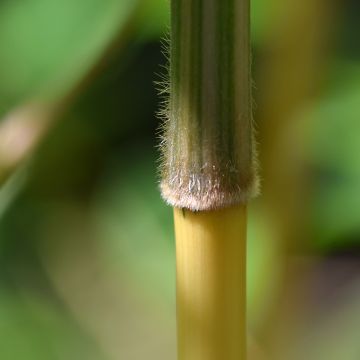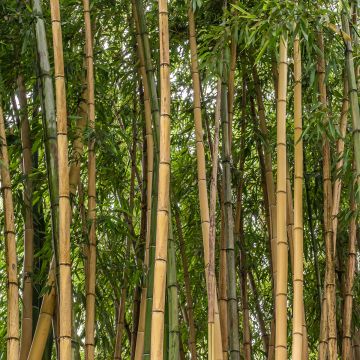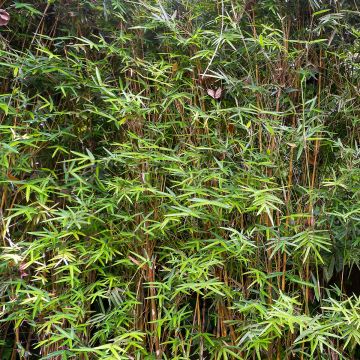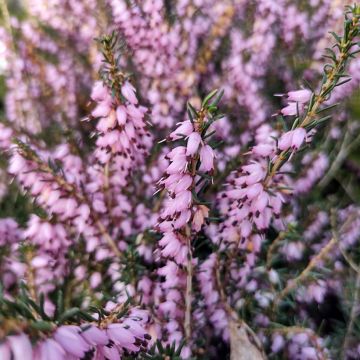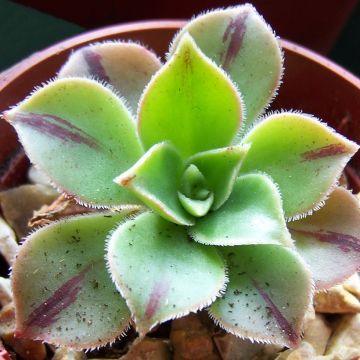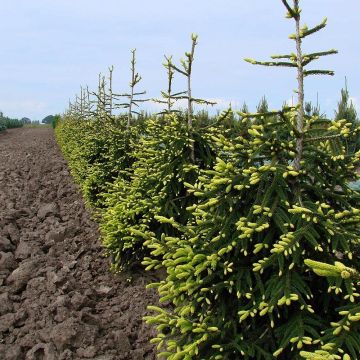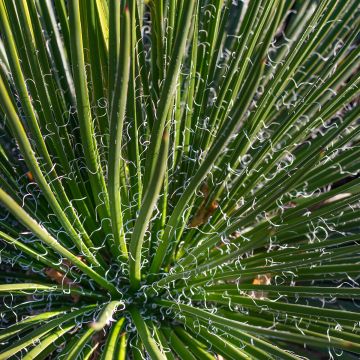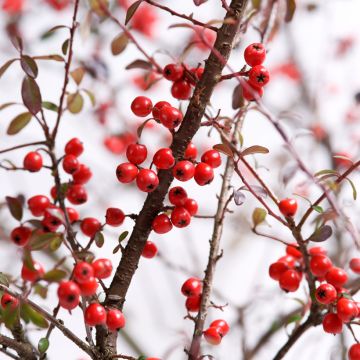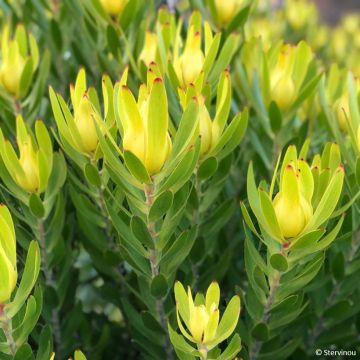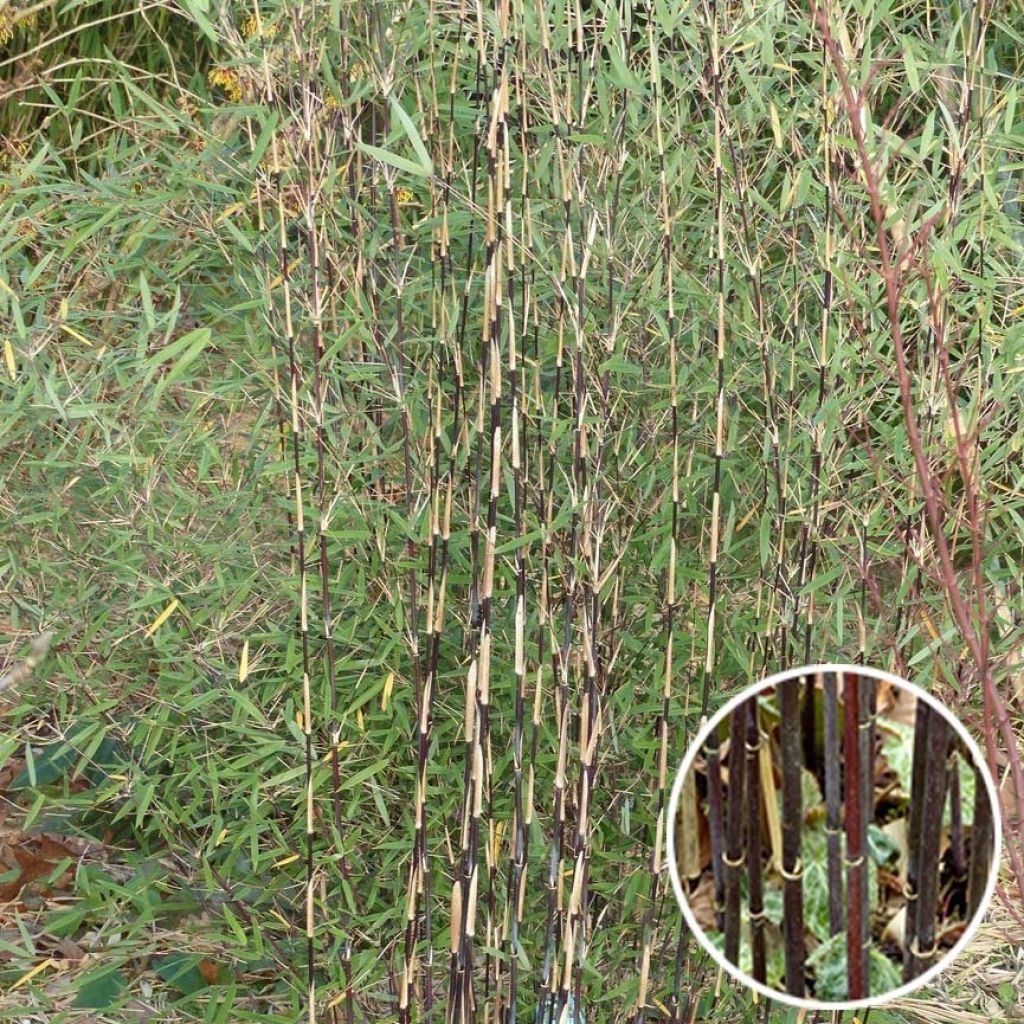

Fargesia sp Jiuzhaigou Deep Purple - Bambou non traçant.
Fargesia Jiuzhaigou Deep Purple
Fargesia sp Jiuzhaigou Deep Purple ®
Fountain Bamboo, Chinese Fountain Bamboo
Healthy plant. Thriving well in a pot. I haven't really seen the colourful graphic aspect of the midrib that I liked yet, but it's still a young plant, I'll wait to see later.
Karine, 06/11/2024
Special offer!
Receive a €20 voucher for any order over €90 (excluding delivery costs, credit notes, and plastic-free options)!
1- Add your favorite plants to your cart.
2- Once you have reached €90, confirm your order (you can even choose the delivery date!).
3- As soon as your order is shipped, you will receive an email containing your voucher code, valid for 3 months (90 days).
Your voucher is unique and can only be used once, for any order with a minimum value of €20, excluding delivery costs.
Can be combined with other current offers, non-divisible and non-refundable.
Home or relay delivery (depending on size and destination)
Schedule delivery date,
and select date in basket
This plant carries a 24 months recovery warranty
More information
We guarantee the quality of our plants for a full growing cycle, and will replace at our expense any plant that fails to recover under normal climatic and planting conditions.
Would this plant suit my garden?
Set up your Plantfit profile →
Description
The Fargesia sp Jiuzhaigou Deep Purple is a brand new variety of non-invasive bamboo that is truly breathtaking, discovered at an altitude of 3000m (9842 ft 6 in) in the northern province of Sichuan, China. This highly promising Fargesia is unique for the colour of its culms, a deep purple leaning towards red or even mahogany. Its modest size, less than 3m (9 ft 10 in) in height, does not prevent it from showing vigorous growth and a dense upright habit. Its tiny evergreen leaves, dark green in colour, adorn branches of the same reddish-purple, making this bamboo a very beautiful plant for partial shade. Like all Fargesia, it grows quickly in height but spreads slowly over the years without ever becoming invasive. Place it in a pot on the terrace or display it as a work of art.
The Fargesia ssp.Jiuzhaigou is sometimes considered a subspecies of Fargesia nitida, although it is no closer to it than F. denudata is to F. murielae according to some specialists in these plants. It is a plant of the grass family, a type of woody-stemmed grass that develops from a non-invasive rhizomatous rootstock, known as a clump-forming species. In this type of bamboo, the very short internode rhizomes slowly develop on the periphery of the rootstock, gradually expanding the clump, but they also develop towards the centre of the clump, keeping it very dense without thinning out in the middle. The Fargesia ssp.Jiuzhaigou 'Deep Purple' is part of a collection of 11 varieties imported from China, specifically from the Jiuzhaigou mountain. The different clones have recently been imported and propagated in Germany for the European market. This variety is perfectly hardy, withstanding temperatures as low as -20/-25°C.
'Deep Purple' forms a dense clump from bottom to top, reaching a height of about 2 to 3m (6 ft 7 in to 9 ft 10 in) at maturity. Its growth rate is quite fast, around 20 to 40cm (7.9 to 15.7 in) per year, depending on the growing conditions. When fully established, the plant will spread up to 2m (6 ft 7 in) on the ground. The culms are upright, straight and slender, about 1cm (0.4 in) in diameter, but sturdy, with a plum colour and covered in bloom when young. Over time, they take on a deep reddish-purple colour with strong brown undertones. In the first year, the culms bear only a few leaves. The foliage on the culms is evergreen and mainly concentrated towards the top of the plant. Abundant, the leaves are small, narrow, lanceolate and tapering at the tips. They are a fairly dark green colour, with a matte finish, forming a striking contrast with the dark colour of the culms.
The remarkably colourful, tall and fast-growing Fargesia ssp.Jiuzhaigou is perfect as a standalone shrub or in a large pot or container on a balcony or terrace. It can also be used, on its own or mixed with other Fargesia, to create a small hedge or a green screen. It blends well with a shrub bed with Japanese maples, hydrangeas, Mahonia. For example, you can plant Brunnera macrophylla Jack Frost at its base and surround it with lush perennials: tall grasses, hostas, giant cannas, as well as tall dahlias (Dahlia imperialis) or climbing aster Aster carolinianus will also make good companions for this beautiful bamboo. To add an unexpected touch to its foliage in summer, you can pair it with a red-flowering viticella-type clematis (Madame Julia Correvon, purpurea Plena Elegans, Avant Garde) whose stems will intertwine with the black culms, their small leaves blending naturally with the foliage of this stunning bamboo.
Report an error about the product description
Fargesia Jiuzhaigou Deep Purple in pictures
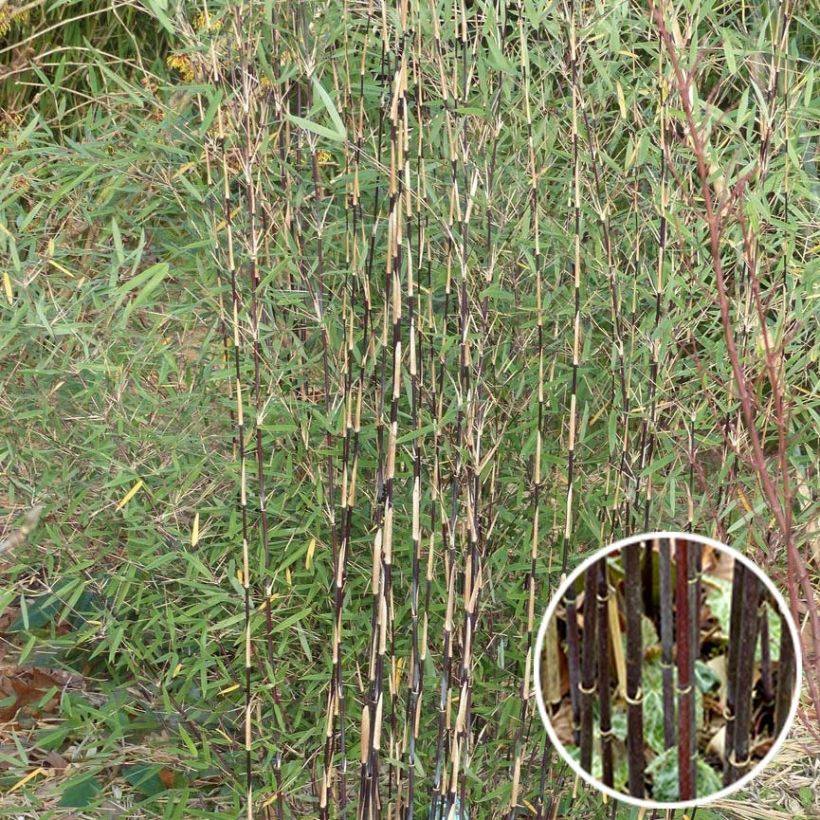

Plant habit
Foliage
Botanical data
Fargesia
sp Jiuzhaigou
Deep Purple ®
Poaceae
Fountain Bamboo, Chinese Fountain Bamboo
China
Other Bamboos
View all →Planting and care
The Fargesia Deep Purple does well in partially or fully shaded areas, especially in warm climates. It's sensitive to too much sun and drought, so keeping it in a shady position and well-watered is essential. When planting, choose moist, rich soil, and avoid limestone. It's best to plant in the spring or autumn in mild climates and leave enough space to grow over time, as it can spread up to 10 metres (32 feet 10 inches). The mature plant requires about 20 litres of water per week during hot periods and 10 litres for the rest of the year. If you choose to plant it in a pot, monitor watering carefully and add two handfuls of fertiliser at the base of the bamboo from early March to mid-April. This will help keep its foliage green. Be aware that slugs can eat young shoots. Unlike other Fargesia types, this non-invasive bamboo doesn't require a rhizome barrier when planting. It retains its green foliage in winter but may lose some leaves depending on the temperature throughout the year.
Planting period
Intended location
Care
-
, onOrder confirmed
Reply from on Promesse de fleurs
Similar products
Haven't found what you were looking for?
Hardiness is the lowest winter temperature a plant can endure without suffering serious damage or even dying. However, hardiness is affected by location (a sheltered area, such as a patio), protection (winter cover) and soil type (hardiness is improved by well-drained soil).

Photo Sharing Terms & Conditions
In order to encourage gardeners to interact and share their experiences, Promesse de fleurs offers various media enabling content to be uploaded onto its Site - in particular via the ‘Photo sharing’ module.
The User agrees to refrain from:
- Posting any content that is illegal, prejudicial, insulting, racist, inciteful to hatred, revisionist, contrary to public decency, that infringes on privacy or on the privacy rights of third parties, in particular the publicity rights of persons and goods, intellectual property rights, or the right to privacy.
- Submitting content on behalf of a third party;
- Impersonate the identity of a third party and/or publish any personal information about a third party;
In general, the User undertakes to refrain from any unethical behaviour.
All Content (in particular text, comments, files, images, photos, videos, creative works, etc.), which may be subject to property or intellectual property rights, image or other private rights, shall remain the property of the User, subject to the limited rights granted by the terms of the licence granted by Promesse de fleurs as stated below. Users are at liberty to publish or not to publish such Content on the Site, notably via the ‘Photo Sharing’ facility, and accept that this Content shall be made public and freely accessible, notably on the Internet.
Users further acknowledge, undertake to have ,and guarantee that they hold all necessary rights and permissions to publish such material on the Site, in particular with regard to the legislation in force pertaining to any privacy, property, intellectual property, image, or contractual rights, or rights of any other nature. By publishing such Content on the Site, Users acknowledge accepting full liability as publishers of the Content within the meaning of the law, and grant Promesse de fleurs, free of charge, an inclusive, worldwide licence for the said Content for the entire duration of its publication, including all reproduction, representation, up/downloading, displaying, performing, transmission, and storage rights.
Users also grant permission for their name to be linked to the Content and accept that this link may not always be made available.
By engaging in posting material, Users consent to their Content becoming automatically accessible on the Internet, in particular on other sites and/or blogs and/or web pages of the Promesse de fleurs site, including in particular social pages and the Promesse de fleurs catalogue.
Users may secure the removal of entrusted content free of charge by issuing a simple request via our contact form.
The flowering period indicated on our website applies to countries and regions located in USDA zone 8 (France, the United Kingdom, Ireland, the Netherlands, etc.)
It will vary according to where you live:
- In zones 9 to 10 (Italy, Spain, Greece, etc.), flowering will occur about 2 to 4 weeks earlier.
- In zones 6 to 7 (Germany, Poland, Slovenia, and lower mountainous regions), flowering will be delayed by 2 to 3 weeks.
- In zone 5 (Central Europe, Scandinavia), blooming will be delayed by 3 to 5 weeks.
In temperate climates, pruning of spring-flowering shrubs (forsythia, spireas, etc.) should be done just after flowering.
Pruning of summer-flowering shrubs (Indian Lilac, Perovskia, etc.) can be done in winter or spring.
In cold regions as well as with frost-sensitive plants, avoid pruning too early when severe frosts may still occur.
The planting period indicated on our website applies to countries and regions located in USDA zone 8 (France, United Kingdom, Ireland, Netherlands).
It will vary according to where you live:
- In Mediterranean zones (Marseille, Madrid, Milan, etc.), autumn and winter are the best planting periods.
- In continental zones (Strasbourg, Munich, Vienna, etc.), delay planting by 2 to 3 weeks in spring and bring it forward by 2 to 4 weeks in autumn.
- In mountainous regions (the Alps, Pyrenees, Carpathians, etc.), it is best to plant in late spring (May-June) or late summer (August-September).
The harvesting period indicated on our website applies to countries and regions in USDA zone 8 (France, England, Ireland, the Netherlands).
In colder areas (Scandinavia, Poland, Austria...) fruit and vegetable harvests are likely to be delayed by 3-4 weeks.
In warmer areas (Italy, Spain, Greece, etc.), harvesting will probably take place earlier, depending on weather conditions.
The sowing periods indicated on our website apply to countries and regions within USDA Zone 8 (France, UK, Ireland, Netherlands).
In colder areas (Scandinavia, Poland, Austria...), delay any outdoor sowing by 3-4 weeks, or sow under glass.
In warmer climes (Italy, Spain, Greece, etc.), bring outdoor sowing forward by a few weeks.































